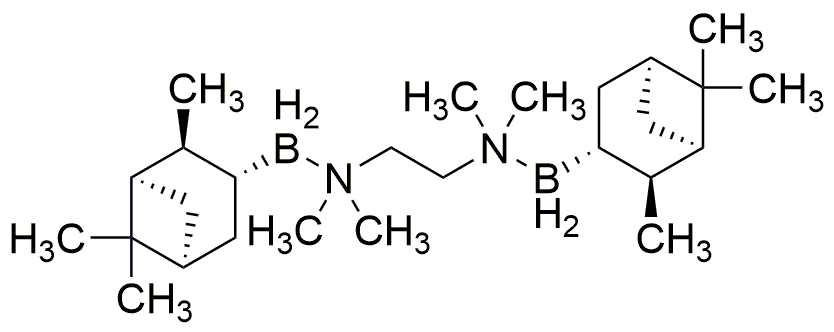(-)-Isopinocampheylborane TMEDA Complex is widely utilized in research focused on various applications, particularly in organic synthesis and catalysis.
- Asymmetric Synthesis: This compound is crucial in the synthesis of chiral molecules, which are important in pharmaceuticals. Its ability to facilitate enantioselective reactions makes it valuable for creating drugs with specific desired effects.
- Catalyst in Organic Reactions: It serves as an effective catalyst in various organic reactions, such as hydroboration. This application is particularly beneficial in the production of fine chemicals and agrochemicals.
- Research in Material Science: The compound is used in the development of new materials, including polymers and nanomaterials, due to its unique reactivity and properties.
- Environmental Chemistry: It plays a role in the study of environmental processes, helping researchers understand the behavior of pollutants and develop methods for remediation.
- Advancements in Organometallic Chemistry: This complex contributes to the advancement of organometallic chemistry, providing insights into reaction mechanisms and leading to the discovery of new catalytic processes.
Informations générales
Propriétés
Sécurité et réglementation
Applications
(-)-Isopinocampheylborane TMEDA Complex is widely utilized in research focused on various applications, particularly in organic synthesis and catalysis.
- Asymmetric Synthesis: This compound is crucial in the synthesis of chiral molecules, which are important in pharmaceuticals. Its ability to facilitate enantioselective reactions makes it valuable for creating drugs with specific desired effects.
- Catalyst in Organic Reactions: It serves as an effective catalyst in various organic reactions, such as hydroboration. This application is particularly beneficial in the production of fine chemicals and agrochemicals.
- Research in Material Science: The compound is used in the development of new materials, including polymers and nanomaterials, due to its unique reactivity and properties.
- Environmental Chemistry: It plays a role in the study of environmental processes, helping researchers understand the behavior of pollutants and develop methods for remediation.
- Advancements in Organometallic Chemistry: This complex contributes to the advancement of organometallic chemistry, providing insights into reaction mechanisms and leading to the discovery of new catalytic processes.
Documents
Fiches de données de sécurité (FDS)
La FDS fournit des informations de sécurité complètes sur la manipulation, le stockage et l’élimination du produit.
Spécifications du produit (PS)
Le PS fournit une description complète des propriétés du produit, notamment sa composition chimique, son état physique, sa pureté et les exigences de stockage. Il détaille également les plages de qualité acceptables et les applications prévues du produit.
Certificats d'analyse (COA)
Recherchez des certificats d'analyse (COA) en saisissant le numéro de lot du produit. Les numéros de lot et de lot se trouvent sur l'étiquette d'un produit, après les mots « Lot » ou « Lot de fabrication ».
Numéro de catalogue
Numéro de lot/série
Certificats d'origine (COO)
Ce certificat d'exploitation confirme le pays dans lequel le produit a été fabriqué, et détaille également les matériaux et composants utilisés et s'il est issu de sources naturelles, synthétiques ou autres sources spécifiques. Ce certificat peut être requis pour les douanes, le commerce et la conformité réglementaire.
Numéro de catalogue
Numéro de lot/série
Fiches de données de sécurité (FDS)
La FDS fournit des informations de sécurité complètes sur la manipulation, le stockage et l’élimination du produit.
DownloadSpécifications du produit (PS)
Le PS fournit une description complète des propriétés du produit, notamment sa composition chimique, son état physique, sa pureté et les exigences de stockage. Il détaille également les plages de qualité acceptables et les applications prévues du produit.
DownloadCertificats d'analyse (COA)
Recherchez des certificats d'analyse (COA) en saisissant le numéro de lot du produit. Les numéros de lot et de lot se trouvent sur l'étiquette d'un produit, après les mots « Lot » ou « Lot de fabrication ».
Numéro de catalogue
Numéro de lot/série
Certificats d'origine (COO)
Ce certificat d'exploitation confirme le pays dans lequel le produit a été fabriqué, et détaille également les matériaux et composants utilisés et s'il est issu de sources naturelles, synthétiques ou autres sources spécifiques. Ce certificat peut être requis pour les douanes, le commerce et la conformité réglementaire.

